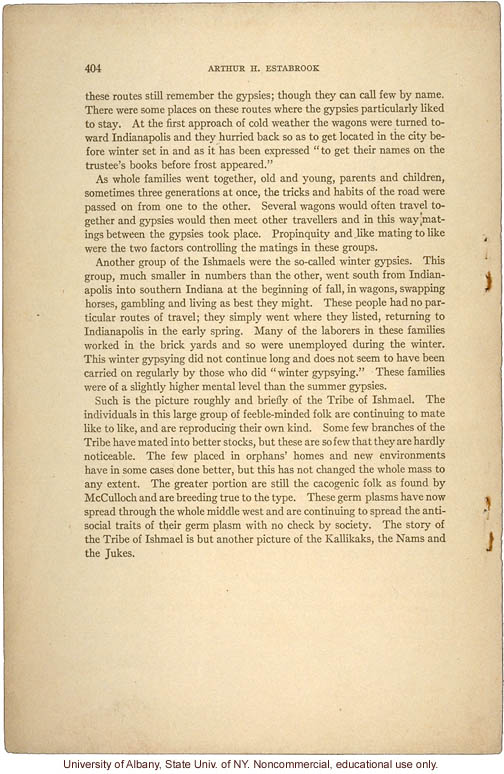404 Arthur H. Estabrook
these routes still remember the gypsies; though they can call few by name. There were some places on these routes where the gypsies particularly liked to stay. At the first approach of cold weather the wagons were turned toward Indianapolis and they hurried back so as to get located in the city before winter set in and as it has been expressed "to get their names on the trustee's books before frost appeared."
As whole families went together, old and young, parents and children, sometimes three generations at once, the tricks and habits of the road were passed from one to the other. Several wagons would often travel together and gypsies would then meet other travelers and in this way matings between the gypsies took place. Propinquity and like mating to like were the two factors controlling the matings in these groups.
Another group of the Ishmaelites were the so-called winter gypsies. This group, much smaller in numbers than the other, went south from Indianapolis into southern Indiana at the beginning of fall, in wagons, swapping horses, gambling and living as best they might. These people had no particular routes of travel; they simply went where they listed, returning to Indianapolis in the early spring. Many of the laborers in these families worked in the brick yards and so were unemployed during the winter. This winter gypsying did not continue long and does not seem to have been carried on regularly by those who did "winter gypsying." These families were of a slightly higher mental level than the summer gypsies.
Such is the picture roughly and briefly of the Tribe of Ishmael. The individuals in this large group of feeble-minded folk are continuing to mate like to like, and are reproducing their own kind. Some few branches of the Tribe have mated into better stocks, but these are so few that they are hardly noticeable. The few placed in orphans' homes and new environments have in some cases done better, but this has not changed the whole mass to any extent. The greater portion are still the cacogenic folk as found by McCulloch and are breeding true to the type. These germ plasms have now spread through the whole middle west and are continuing to spread the anti-social traits of their germ plasm with no check by society. The story of the Tribe of Ishmael is but another picture of the Kallikaks, the Nams and the Jukes.
[end]


